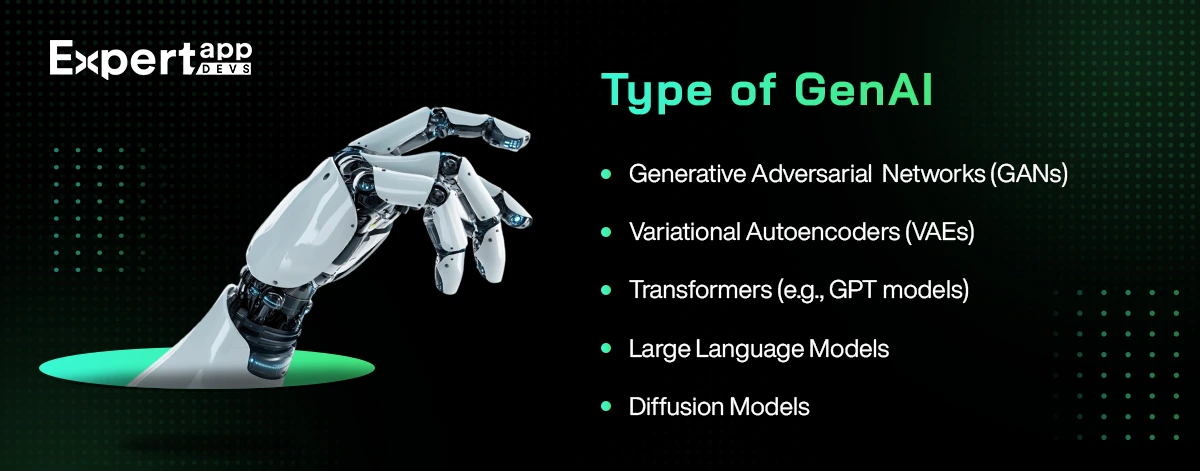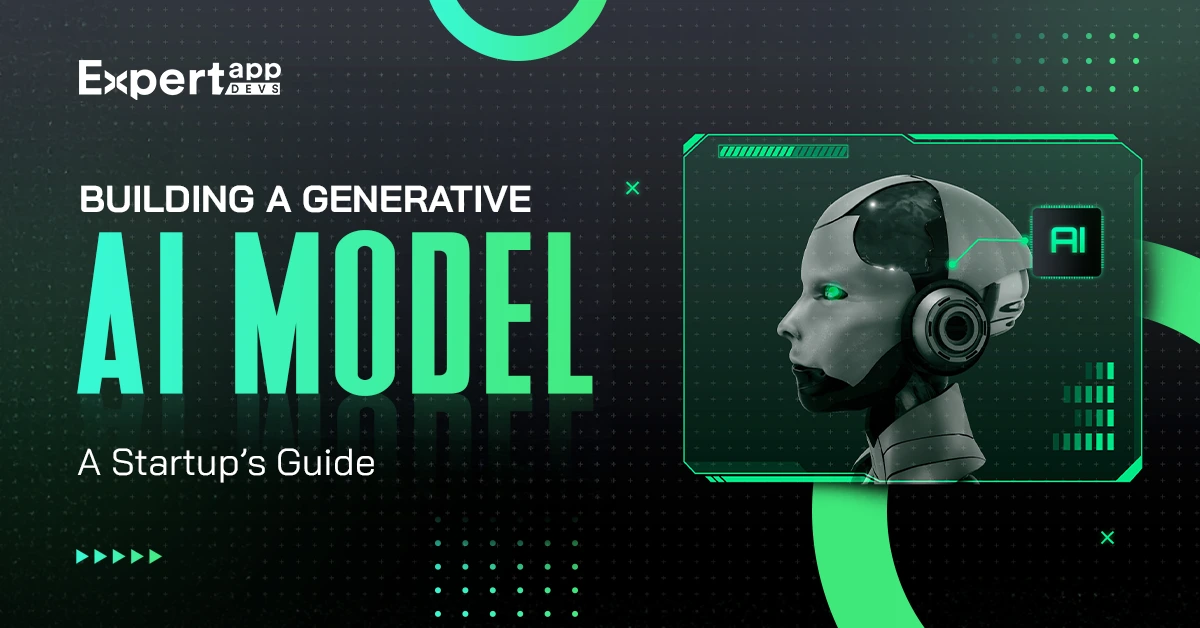How to Build a Generative AI Model for Startup?
Today artificial intelligence has occupied every industry. In fact, there is no harm in saying that it's the biggest and fastest-growing thing in today’s digital world. Fortune Business Insights Research says that the global generative AI market will grow up to USD 967.65 billion by 2032.
Right now, almost every industry is using generative AI to make their business operations easier. The most popular example is ChatGPT itself. Professionals from diverse industries use it to check code, debug, and content writing, students use it to write letters, essays, and more. In the US of America, over 53% of people use gen AI for their daily tasks and 81% use it for their personal work like school and other assignments.
Generative AI might sound simple to you, but there’s a lot of brainstorming and hard work behind the scenes. If you want to know how to create an ai model suitable to your business, then read this article till the end.
What Is Generative AI? Why It's Important For Startups?
Generative AI is basically a part of AI which is based on machine learning technologies. It is also known as Gen AI or generative artificial intelligence. It is capable of creating new content such as audio, video, images, code, scripts, and much more based on user input or pre-trained data.
It's very beneficial for startups who want to set a mark in the industry and stand unique from others. According to a KPMG survey, 72% of CEOs believe that generative AI is the best investment for the organization, no matter what economic condition is.
It is important for startups because it helps them to work on multiple prototypes and speed up the ideation phase according to the user input and deliver better AI solutions. This can be a bit costly investment for startups. But this helps to reduce operational costs and automate tasks to speed up the task and boost overall productivity.
Overall, with AI, it’s a win-win! Businesses get profits, and users get what they actually want.
Types of Generative AI
There are various types of gen AI models and every model is designed to perform its own unique task or use cases. By choosing a suitable model and training them according to your data sets and inputs, you can make magical innovations for your business.
Explore below which type of GenAI is useful for what type of task!

#1. Generative Adversarial Networks (GANs)
GAN was founded in 2014. It is a deep-learning model that is useful for generating synthetic images and text. It operates on two main components that is generator and a discriminator. The generator is responsible for generating synthetic data that relates to real data and the distinguisher is responsible for checking whether the data is authentic or not.
This Gen AI is useful in fields like medical and research science that need to get real data. This makes data augmentation and pre-processing techniques easier.
#2. Variational Autoencoders (VAEs)
This gen model has a combination of autoencoders and probabilistics. This uses encode-decode architecture to capture and generate complex data. The best part about VAEs is that it can reconstruct data to have various possibilities of data sets.
It is mainly useful for practical applications like anomaly detection, data compression, drug discovery, and more.
#3. Transformers (e.g., GPT models)
One of the famous examples of transformer-based models is ChatGPT. Here data is trained by users using machine learning and NLP(natural language processing). Transformers models are good at dealing with complex data relationships. it is best for text generation, information retrieval, language translation, and many other writing and thinking tasks.
This is useful in making day-to-day tasks easier.
#4. Large Language Models
Next comes large language models. These are more advanced than traditional AI models like GPT, Gemini, Claude, etc. because this model is based on neural networks to think and predict like a human.
Here, a large amount of data is trained to learn about the text, and their relationship and predict the next text based on that. So, it's basically like human minds think and work.
#5. Diffusion Models
This model uses iterative denoising. It uses diffusion technology and contrastive learning to understand the difference between similar images and new ones. It is useful in creating photorealistic images, animations, and videos from the text.
Many advertisements, design companies, and content creators are already using these diffusion models to generate attractive designs and animations.
So now you know about different types of generative AI models, it's time to create a generative AI model.
How To Begin With Building Generative AI?
Building any generative AI is a journey of patience and organized execution. Here each phase contributes its importance in its own way. Below we have explained the step-by-step guide to make your genAI model-building journey easier. Walk with us to learn more about how to make an AI model.
#1. Identify The Problem In The Scenario
Every technological invention is started first by identifying the problem. You must have some goals and purpose for building the Gen AI model. So begin with identifying the problem of your business and based on that whole process will be decided. The best thing I would suggest is to go for identifying real problems that are actually creating trouble for users.
The problem can be anything like product design, marketing, ideation, customer experience, and more. Identifying the right problem will make your base stronger and increase your chances of taking your AI model viral.
#2. Gathering Data
The AI model is fully dependent on the data you input for processing. So collect high-quality data for more efficiency. Make sure you are collecting the data from an original and secure place. AI model works better when you provide more amount of data and that is too accurate.
Pro-tip is to focus on your business features that are important for your business and collect and clean the data relevant to that.
This does not end with data collection. Once the good data is collected, it is refined and cleaned to make it ready for processing.
#3. Choose A Suitable Gen AI Algorithm
This is an important step. The gen AI algorithm you choose will decide the output. Because the gen AI model will perform the entire execution. No doubt, every model is the best in their own way but consider your business needs, and the type of data you are gonna process like AI PDF, text, images, code, video, embeddings, and more.
To get more clarity, you can go through the types of Gen AI models and decide accordingly which type of model is suitable for what task.
#4. Building AI Model
Once you decide AI model, it's time to get into the action phase. Here you need to decide a lot of things like the framework, and tools you need to use.
The development phase includes inputting the right data sets into the AI model. Training and fine-tuning of data is the main part here.
- Follow the best practices like setting optimal batch size, learning rate, and number of epochs for efficient learning of data.
- Avoid overfitting or underfitting.
- Train the model according to different use cases by customizing pre-trained models with domain-specific data. This will help you to see the output of the data set you are inputting.
- Keep fine-tuning and optimizing until it meets your project requirements.
- Set up the development environment using the necessary hardware, software, libraries, tools, and technologies.
There are also some important criteria involved in the development stage, make sure of this too.
- Choose proper and secure storage.
- Use suitable AI tools for cleaning and data processing.
- Design your code to handle multiple tasks.
- Use containers for easy deployment.
- Use cloud computing and caching techniques.
- Use microservices for independence.
- Use message queues.
- Balance workloads to prevent server overloading.
- Error handling and maintaining documentation.
- Disaster recovery.
It is best to hire an experienced AI developer if your need is a complex AI solution. AI developers can handle all steps properly and develop more effectively.
#5. Testing And Evaluation
Once you are done with your generative AI solution development. It must be tested properly to make sure it aligns with the business goals and objectives. Test your AI solution against all testing such as performance testing, unit testing, A/B testing, functional, user testing, validation checks, and more.
Fine-tune and repair the things that are not working properly. It is best to hire a highly-skilled QA tester to ensure the AI model is free from bugs and operates perfectly fine.
#6. Deploying The Generative AI
Now we are almost near to the last step. Here the AI model is moved to a real-world environment. Consider hardware needs, computational needs, and other requirements to make sure deployment is hassle-free.
#7. Maintenance And Improvements
With the changing world, it's important to keep the AI solution updated with the latest advancements. This phase is important to maintain the AI model quality and make the user experience good. This step includes refining the algorithm, optimizing things as per user feedback, and more.
Best Practices For Building Generative AI Solutions
Best practice is a must if you really want to develop a good AI solution for your business. Technologies are continuously changing, but following best practices and methods can future-proof your AI model which can be easily scaled with the growing needs.
Here are some pro tips you can follow.
#1. Identify Specific Parts Of The Business And Get High-Quality Data
Just gathering data is not enough. The more you dig deeper, the more quality data you can find. Focus on specific areas where generative AI creates more value like automating repetitive tasks, customer interactions, or personalizing user experience, and try to extract high-quality data on that.
Pro tip: talk with domain experts. They will help you to find the critical points that need more attention.
#2. Prioritize Security And Privacy
Encryption and access control are a must. Make sure you are collecting data from trusted sites. Regularly conduct AI audits and update your AI system to protect it from threats and vulnerabilities.
Avoid using data from anonymous sites and follow all data security measures like GDPR, CCPA, and more.
#3. Train And Tune The AI Model
Training the AI model is the base. It is like training a baby, It learns as you teach it. Some of the things that matter here are:
- High-quality data.
- by choosing the right batch size.
- learning rate, and number of epochs.
- Fine-tuning the pre-trained model to adapt to your specific business needs.
- Lastly, keep the model evaluating and refining until you get the desired results.
#4. Keep Your Gen Ai Model Updated
Make sure your AI model is up-to-date with all the latest features and functionalities. Because no one uses outdated things. Keep monitoring it and refine it with fresh data from time to time.
Your AI solution should be efficient as well as effective also then only you can create a unique place in this competitive world. Keep updated with the new security threats and challenges to make suitable improvements in algorithms and infrastructure.
Conclusion
In past history, AI was already used by many researchers in the 1950’s. Today we are in the era where AI is used in every industry for some or other purpose to make the business run more smoothly. If you want to gain more from your business, you must invest in AI solutions. In this blog, we have discussed the steps to build a generative AI model and the best practices to keep improving your AI solutions.
If you are a startup, a generative AI model can be the best thing because it helps to innovate faster and grow in the market.
Expert App Devs can be your trusted partner if you need assistance or any help with AI model. We can give you proven strategic solutions and contribute to your AI model invention. Reach us today by filling in the inquiry details and we'll get back ASAP!
Frequently Asked Questions
#1. How much data do I need to train a generative AI model?
The amount of data you need depends on the Gen AI model you are developing. According to the thumb rule, it's said that the generative AI model needs 10 times more data points than the number of parameters to avoid errors.
You can start with the data you have current and go on expanding as needed.
#2. What are some common challenges in building generative AI models?
There are many challenges that come while building a generative AI model. Challenges start from data collection, preprocessing a high amount of data, ensuring data quality and bias, security, optimizing computation resources, and much more.
#3. Can a generative AI model scale with my startup’s growth?
Yes, you can scale a generative AI model as your startup grows. It can be scaled using cloud computing, parallel processing, microservices and perform regular updates and optimization.
#4. How do I ensure the ethical use of generative AI in my startup?
To maintain ethical use, first avoid biases in the training data, and comply with the privacy laws. Put in place some safety measures to avoid those misusing the software, like rules for usage and audits carried out on a regular basis. Discuss AI's impact with stakeholders and make sure the technology aligns with your company's values.
 Jignen Pandya
Jignen Pandya




